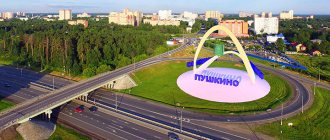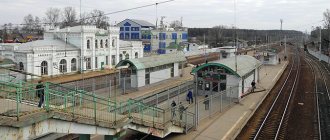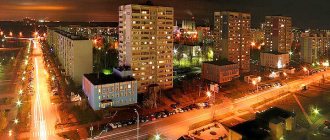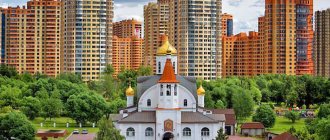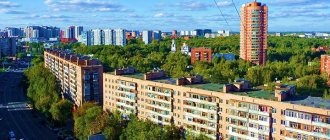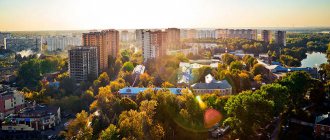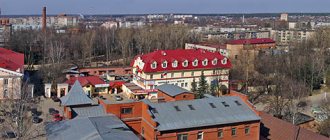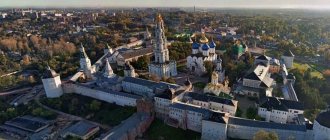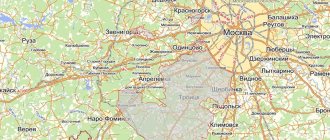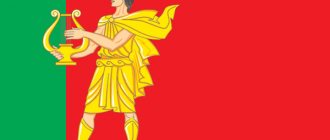This term has other meanings, see Moscow.
| City | |
| Moscow | |
| Flag | Coat of arms |
Moscow
Moscow
Media files on Wikimedia CommonsMoscow
- a city[2], the administrative center of the Moskovsky settlement, part of the Novomoskovsky administrative district of the city of Moscow. Until July 1, 2012 - a city of regional subordination, belonging to the Leninsky district of the Moscow region (until 2004 - a rural locality, the village of Moskovsky[3]).
Content
- 1. History
- 2 Population
- 3 City structure
- 4 Education 4.1 Current status
- 4.2 History
- 7.1 Palace of Culture "Moskovsky"
- 10.1 Ground transport
- 11.1 Printed publications
Story
It was founded on the site of the village of Peredeltsy, which was located on the territory of the modern second and third stages of the greenhouse complex of the former Moskovsky state farm. In 1994-2006 it was the center of the Moscow rural district. The name is due to the fact that the specified state farm, at that time located on the territory of the Moscow region, belonged to the city executive committee of the city of Moscow. The distance to the Moscow Ring Road is 8 km. In the 2010s, a district of multi-storey residential buildings was built on the site of the greenhouses.
- Moskovsky in a satellite image from 2000
Central administrative district of Moscow
Ooo! This is the legendary historical center of Moscow with a rich history. Indescribably beautiful and experienced a huge number of both terrible and joyful events. It is home to 782 thousand people.
Central includes 10 districts: Arbat, Basmanny, Meshchansky, Khamovniki, Tverskoy, Tagansky, Presnensky, Zamoskvorechye, Krasnoselsky, Yakimana. Sometimes you can hear about Kitay-gorod, but territorially it belongs to the Tver district.
Central district of Moscow and its areas
The Central District has the most expensive real estate. Here are the most famous sights of Moscow, such as the Kremlin, Red Square, the already legendary Moscow City complex, Zaryadye Park and others.
The Central District is the dream of life for many people, but there are also disadvantages. Constant bustle, a huge number of people, sky-high housing prices. Many streets are often blocked due to city events.
Population
| Population | ||||||
| 1979[4] | 2002[5] | 2006[6] | 2009[7] | 2010[8] | 2012[9] | 2013[10] |
| 9324 | ↗15 563 | ↗15 755 | ↘15 649 | ↗17 366 | ↗18 268 | ↗20 386 |
| 2014[11] | 2015[12] | 2016[13] | 2017[14] | 2018[15] | 2019[16] | 2020[17] |
| ↗24 210 | ↗33 128 | ↗39 784 | ↗50 167 | ↗53 417 | ↗57 537 | ↗59 218 |
| 2021[1] | ||||||
| ↘59 196 | ||||||
City structure
| The section lacks links to sources. Information must be verifiable or it may be deleted. You can edit the article to add links to authoritative sources. This mark was set on May 12, 2011 . |
Microdistricts “First Moscow City-Park” and “Moscow City”
The city consists of four microdistricts: microdistrict 1, microdistrict 3 (“South-West”), microdistrict 4 (“Moskovsky Grad”) and microdistrict 5 (“First Moscow City”) -a park").
Microdistrict 1
. It is a historical part of the city. The first five-story panel houses were built in the mid-1960s for state farm workers. Subsequently, multi-storey buildings (9-16 floors) were erected. The number of residential buildings is 50.
Microdistrict 3 (“South-West”)
. This microdistrict has 16 multi-storey residential buildings with a total area of 288 thousand m².
Microdistrict 4 (“Grad Moskovsky”)
. A microdistrict of four blocks. Trade enterprises and offices were located on the ground floors of residential buildings. The microdistrict stands out for its number of storeys; there are 17- and 25-storey buildings.
Microdistrict 5 (“First Moscow City Park”)
. Construction began at the end of 2011 on the territory of the first stage of the greenhouse plant.
The name of Georgievskaya Street in the Moskovsky City microdistrict comes from the Church of St. George the Victorious, which was previously located here, which was dismantled in the 30s of the 20th century. In 2010, on the site where the altar of the destroyed temple was approximately located, a Memorial Cross was installed and consecrated.
Prospects
According to experts, residential real estate in the city of Moskovsky will become even more in demand: the reason for this is the proximity to the capital, the massive commissioning of new housing and the fact that prices on the market for new buildings in Moskovsky are not yet so high.
What can be concluded? The city of Moscow has a certain investment attractiveness and favorable prospects, and is an interesting object for those who want to invest available funds in real estate in order to subsequently make a profit from resale or rental.
Apartments in new buildings in Moskovsky are more affordable than their analogues, for example, in Podolsk, because the main segment of housing being built is economy and economy+: these are standard panel houses of well-proven series (for example, P-44T, which flooded Moscow at the very end of 1990- x - early 2000s) without security, parking and with not very high ceilings, partial possibility of redevelopment, but allowing the owner to buy a larger number of square meters for himself and his future family compared to, say, a monolithic house of an individual project.
Did you find this article helpful? Please share it on social networks: Don't forget to bookmark the Nedvio website. We talk about construction, renovation, and country real estate in an interesting, useful and understandable way.
Education
Current state
Kindergarten on Bianchi Street.
The infrastructure of the city's educational system includes all types and types of general, preschool and additional education[18]. There are two educational complexes in Moskovsky - State Budgetary Educational Institution “School No. 2120” and State Budgetary Educational Institution “School No. 2065”. The former unified complex of the State Budgetary Educational Institution “School No. 2065” included 13 structural divisions: 5 school buildings (No. 1-5) and 12 kindergartens (No. 2-13, kindergarten No. 1 is located in the Polio Institute Village)[18]. The total number of students in all structural divisions as of September 1, 2015 was 7,883 people[19]. At the end of the 2015/2016 academic year, School No. 2065 took 73rd place in the ranking of Moscow schools[20].
In the GBOU “School No. 2120” there are cadet classes named after E. N. Chernyshev[21], museums have been created in the first building of the school[22][23], a school newspaper is published, officially registered in the school register[24].
In May 2021, a project was agreed upon for the construction of the fifth building of the State Budgetary Educational Institution “School No. 2120” for 1000 students in the “Grad Moskovsky” microdistrict, which will include classrooms, computer science and computer science classrooms, cooking, a laboratory, a computer-linguistic laboratory, and a workshop for processing wood, metal and fabric. In addition, there is a dining room with 530 seats, an auditorium, a choreography studio and a library with a reading room and a media library[25].
Story
In 1971, in the first microdistrict of the city, the first school was built according to a standard design - school No. 1 (now building No. 1 of the State Budgetary Educational Institution "School No. 2065")[26]. In 1979, the same school building No. 2 was built nearby (now building No. 2 of the State Budgetary Educational Institution “School No. 2065”)[26]. On May 8, 1981, at school No. 2, the museum “Combat Glory of the 70th Infantry Upper Dnieper Order of Suvorov Division” was opened[27], and in 1985, at school No. 1 - the museum “History of the Native Land”[28].
In October 2008, in the third microdistrict, as part of the construction program for the Yugo-Zapadny residential complex, a new school building was opened (now building No. 3 of the State Budgetary Educational Institution “School No. 2065”)[29]. The school has a capacity of 1,100 students; it has 2 gyms, a gym, a choreography room, 2 computer classes, a library with a reading room, a dining room and medical rooms, an aesthetic education block, a large assembly hall with a universal stage, dressing rooms, a costume room and a radio room[29]. After the opening, School No. 2 and the Children's Art School moved into this building[27].
On September 1, 2011, school No. 3 “Vector” was opened in the fourth microdistrict (now building No. 4 of the State Budgetary Educational Institution “School No. 2065”), designed for 825 students[30].
From September 1, 2012, after the inclusion of the city of Moskovsky into the city of Moscow, the numbering of schools was changed: school No. 1 received number 2063, school No. 2 - number 2064, school No. 3 - number 2065. In 2014, during the reorganization of educational institutions in the city of Moscow All schools and kindergartens in the city of Moskovsky were united into a single educational complex - State Budgetary Educational Institution “School No. 2065”.
Infrastructure
The city-forming enterprise is the Moskovsky Agricultural Plant. The agricultural complex's greenhouses, in which vegetables and flowers are grown, are spread over a vast territory. The agricultural complex is recognized as the largest in Russia and one of the largest in Europe.
In general, I must say, the residents of the city were very lucky with the city-forming enterprise. The agricultural complex produces organic vegetables and herbs, not coke or coal of any kind; in addition, it actively participates in the life of the city and region: it opens interesting sites, holds competitions for children, and promotes a healthy lifestyle and concern for the environment in a playful and educational way.
It should be noted that residents of Moskovskoye can not only consume greens in pots from the agricultural complex every day, but also admire the “greenery” on a larger scale - natural forests have been preserved around the city; in Moskovskoye itself, landscaping and landscaping of walking areas are actively underway.
Two small rivers are located within the city limits, and outside the city flows one of the largest rivers near Moscow, the Desna, which allows you to swim, fish, and engage in water sports.
Culture and art
In Moskovskoe there are adult and children's libraries, a palace of culture, a children's art school, and three school museums.
Palace of Culture "Moskovsky"
In the first microdistrict there is the Moskovsky Palace of Culture, built in 1971-1988 according to the design of architects Dmitry Solopov and Mikhail Kazarnovsky[31]. The building was built in the style of Soviet modernism, the foyer with an area of 1,200 m2[32] is decorated with mosaic panels using the Florentine mosaic technique[31]. The Palace of Culture houses a cinema and a stage with a hall for 509 people, several halls and auditoriums with a capacity of up to 100 people for cultural events, and a recording studio[32]. Recently, a major overhaul of the auditorium and dance halls, rooms for children's activities and the future family cafe were carried out[33].
The institution is the center of cultural and educational work of the city. The cultural center organizes the work of more than twenty clubs, studios, amateur creative groups, and interest clubs of various types for children, adolescents and adults[34]. Creative teams of the Palace of Culture become laureates, diploma winners, prize-winners and participants in numerous international and Russian competitions and festivals[33]. Performances, concerts, circus performances, and exhibitions are regularly held[35]. Guests of the Palace of Culture were many popular artists: Nadezhda Babkina, Diana Gurtskaya, Alexander Marshal, Tatyana Bulanova, Vyacheslav Dobrynin, Klara Novikova, Alexander Serov, Kostya Tszyu, the groups “Tea for Two”, “Lube”, “Brilliant”, “Golden Ring” , “Ex-BB”, “Pesnyary”, “Mirage” and many others[33].
Libraries
Library No. 259 operates in the Moskovsky Palace of Culture. The library collection amounts to 23,000 copies, and in addition, access to electronic resources of libraries in Russia and the world is provided[36]. The library has children's and adult sections, as well as a media center where you can work on the computer, listen to audio books, watch films, and the library lobby is a bookcrossing area[36]. In addition, the library regularly hosts events, exhibitions, festivals, and meetings with writers; educational clubs for children were organized[36]. The library of the city of Moskovsky is currently the largest of the libraries of the Centralized Library System "Novomoskovskaya" (includes 11 libraries of the TiNAO) [36].
The library began its history in 1948, when its first head, Alexandra Mitrofanovna Buravchikova, began collecting book collections from houses in the then village of Peredeltsy. Later, on the initiative of the director of the collective farm, she began the creation of a library, which was officially registered by the cultural department in 1950[36][37]. She was allocated a place at the Peredeltsevsky Club[38]. By December 1979, the volume of the library collection was about 5,000 copies[37][38]. Since 1980, the library has been located in the same building as the Children's Art School[38]. In 1988, the library was divided into a children's and an adult library[38]. For 15 years, the children's library did not have a permanent premises and moved from place to place, until in March 2001, together with the adult library, it moved to premises in the Moskovsky cultural center[38].
In addition, there are own libraries at the city schools, a library of spiritual literature at the Church of St. Tikhon.
School museums
On May 8, 1981, at school No. 2 (now building No. 3 of the State Budget Educational Institution “School No. 2065”), the museum “Combat Glory of the 70th Infantry Verkhnedneprovskaya Order of Suvorov Division” was opened[27]. The founder of the museum was a teacher of basic military training, Colonel Lebedev Leonid Semenovich[39][40]. The museum's exhibition includes samples of weapons, photographs, handwritten memories and personal belongings of veterans of this division - more than 500 exhibits in total. Meetings are regularly held with veterans of the division, and trips are taken to the battlefields of the division. More than 1000 lectures and excursions were held for school students and guests. The work takes place under the guidance of the museum council, which consists of veterans, teachers and school students. According to the results of a review of school museums, in the 1999/2000 academic year the museum took first place among museums of military glory[39].
On May 12, 1985, at school No. 1 (now building No. 1 of the State Budgetary Educational Institution “School No. 2065”) the museum “History of the Native Land” was opened[28]. The organizer and permanent director of the museum is a history teacher, an excellent student of education in Russia, Larisa Konstantinovna Kaptilkina[28][41]. The museum's exposition is dedicated to the local history of Podolsk district and its environs: the history of local villages, hamlets and their past owners, toponyms and hydronyms, the history of healthcare and education, history during the Second World War. The museum's holdings include ancient Russian coins, household items, elements of Russian ponevnoy costume, personal letters from the front, memories of veterans, personal belongings, and war relics[41]. In April 2014, the museum received certificate No. 1027 from the Moscow Department of Education[42].
On October 22, 2014, the Museum of “Military Glory of Heroes of the Fatherland” was opened in building No. 4 of the State Budgetary Educational Institution “School No. 2065”[43]. The museum's exposition includes exhibits dedicated to the Great Patriotic War, combat operations in Afghanistan and the Chechen campaigns[44]. Nowadays it is part of the State Budgetary Educational Institution “School No. 2120”, in the first building.
Religion
Church of St. Tikhon, Patriarch of All Russia
There are 3 Orthodox churches in the city:
- The Church of St. Tikhon, Patriarch of All Russia (1996-2001), is located at the entrance to the city of Moscow;
- Small Baptismal Church of the Nativity of John the Baptist (1995-1996), assigned to the Church of St. Tikhon;
- Church of the Holy Blessed Prince Andrei Bogolyubsky (2014-2015), located in the 3rd microdistrict.
Before the revolution, on the territory of modern Moscow, at the Peredeltsevskoye cemetery, there was a temple of St. George the Victorious, which was destroyed in the 30s of the 20th century[45].
In 1994, a decision was made to build a Baptist prayer house on the territory of Moscow[46]. This decision caused a resonance among the Orthodox population of the village - it, being a larger community, did not have its own temple[46]. In March 1995, a referendum was held in the village, the purpose of which was to decide which church would be built - Baptist or Orthodox[46]. In the voting, more than 700 people chose the construction of an Orthodox church and only 14 - a Baptist one[46].
The parish was named in honor of St. Tikhon, Patriarch of All Russia. Initially, services were held in one of the apartments in the village. This premises was allocated by the management of the Moskovsky agricultural complex[46][47]. Construction of the small church was completed on October 9, 1996, and on October 20, 1996, the first service took place there[46][47]. According to the plans of the authors of the project, the main temple should have risen next to the small temple. On October 16, 1996, the foundation stone of the future temple was laid and a cross was erected[46][47]. The main building of the temple was built in 2001[46]. On March 2, 2003, the consecration of the temple took place[47]. When services began in the large church, the small church, with the blessing of Metropolitan Juvenaly, was renamed in honor of the Feast of the Nativity of John the Baptist[48]. The church has a Sunday school, a library, and a pilgrimage service[49][50].
In the coming years, there are also plans to revive the destroyed temple in the name of the Great Martyr George the Victorious[45]. It is assumed that a new church with a capacity of 300 people will be built on a site near the Peredeltsevsky cemetery[45]. The construction of a temple on the site of the old one is impossible, since burials have appeared in its place[45].
Features of accommodation
The city of Moskovsky is one of the youngest in the Moscow region (it received city status only in 2004). And today, if I may say so, it is entirely focused on the capital: the majority of those living in the city prefer to go to work in Moscow, since it is very close, as well as to use the capital’s infrastructure for education, shopping, and participation in cultural life.
Clinics, schools, kindergartens and shops within walking distance and larger ones (including the Metro hypermarket, a swimming pool and sports palace, a cinema and sections for children) - all this is in Moskovsky. Therefore, in general, the comfort of living in this city can be assessed at a high level.
Transport
The distance from the city to the Moscow Ring Road is 8 km.
Ground transportation
- Bus routes passing along the Kievskoye Highway: 611
South-Zapadnaya - Troparevo - Vnukovo Plant - 272
Salaryevo - Vnukovo plant - 911
Salaryevo - Vnukovo airport - 304
Salaryevo - Pervomaiskoye - Ptichnoye - Troitsk (Microdistrict B) - 309
Salaryevo — Naro-Fominsk - 490
Salaryevo - Aprelevka - 569
Salaryevo - Selyatino - Taraskovo
- 189
3rd microdistrict of Moskovsky - Filatov Lug
1st microdistrict of Moskovsky - Rasskazovka - Fedosino street
Microdistrict "Grad Moskovsky" - Salaryevo - MEGA Tyoply Stan
Microdistrict "Grad Moskovsky" - Salaryevo[51]
3rd microdistrict of Moskovsky - Filatov Lug - Mosrentgen
3rd microdistrict of Moskovsky - Rasskazovka - Vnukovo platform
Troitsk (Shopping center) - Novovatutinsky Prospekt - 3rd microdistrict of Moskovsky - Salaryevo
platform Kokoshkino - 3rd microdistrict of Moskovsky - Teply Stan
3rd microdistrict of Moskovsky - Maryino - Rakitki - state farm Voskresenskoye
3rd microdistrict Moskovsky - Maryino
Microdistrict "Grad Moskovsky" - Rasskazovka - Solnechnaya platform
3rd microdistrict of Moskovsky - Troparevo - Yugo-Zapadnaya
Moskovsky - Maryino - Desna - MKAD - Vidnoye
- 46
Microdistrict "Grad Moskovsky" - Mosrentgen - MKAD - Auchan - Mega
3rd microdistrict of Moskovsky - Troparevo - Yugo-Zapadnaya
1st microdistrict of Moskovsky - Maryino - Rakitki - Olkhovaya - Teply Stan
Microdistrict "Grad Moskovsky" - Troparevo - Yugo-Zapadnaya
In 2021, the project of a high-speed tram line to the Salaryevo transport hub was approved[52]
Metropolitan
The nearest metro station is Filatov Lug, which is reached by a 3 km long bicycle and pedestrian road from the 4th microdistrict, passing through the Ulyanovsk Forest Park. There are no metro stations in the city. In September 2021, the construction of the route from Bianki Street to the Solntsevo-Butovo-Varshavskoye Highway, which is adjacent to the Filatov Lug metro station, was completed, thanks to which the travel time to the metro was reduced to five minutes[53][54]. At both ends of the route there are large Velobike rental stations and various kick-sharing companies.
In which urban districts of the Moscow region was coronavirus detected as of December 9, 2021?
Identified cases of coronavirus in urban districts of the Moscow region:
- Balashikha 31896 (+143)
- Bogorodsky 10091 (+10)
- Bronnitsy 1714 (+0)
- Vlasikha 435 (+5)
- Volokolamsk 3555 (+42)
- Voskresensk 11320 (+57)
- Dzerzhinsky 4342 (+18)
- Dmitrov 13164 (+84)
- Dolgoprudny 7347 (+14)
- Domodedovo 17238 (+46)
- Dubna 4364 (+3)
- Egoryevsk 6961 (+5)
- Zhukovsky 9723 (+85)
- Zaraysk 4692 (+18)
- Star City 75 (+0)
- Ivanteevka 6785 (+5)
- Istra 10963 (+37)
- Kashira 3367 (+4)
- Klin 9475 (+14)
- Kolomna 14072 (+81)
- Korolev 31859 (+88)
- Kotelniki 3722 (+5)
- Krasnoarmeysk 444 (+1)
- Krasnogorsk 30580 (+76)
- Krasnoznamensk 4341 (+2)
- Leninsky 16238 (+15)
- Lobnya 7627 (+17)
- Losino-Petrovsky 1573 (+2)
- Lotoshino 1317 (+10)
- Lukhovitsy 4111 (+9)
- Lytkarino 4570 (+3)
- Lyubertsy 29911 (+27)
- Mozhaisk 2823 (+8)
- Youth 3 (+0)
- Mytishchi 29244 (+7)
- Naro-Fominsk 6961 (+17)
- Odintsovo 35446 (+10)
- Lakes 2446 (+0)
- Orekhovo-Zuevo 14172 (+44)
- Pavlovsky Posad 4657 (+5)
- Podolsk 22890 (+60)
- Protvino 1086 (+0)
- Pushkino 18929 (+137)
- Pushchino 1266 (+21)
- Ramenskoye 20573 (+12)
- Reutov 8674 (+39)
- Roshal 449 (+0)
- Ruza 4796 (+15)
- Sergiev Posad 21598 (+57)
- Silver Ponds 1961 (+8)
- Serpukhov 9728 (+68)
- Solnechnogorsk 16215 (+45)
- Stupino 8857 (+5)
- Taldom 2452 (+22)
- Fryazino 5736 (+1)
- Khimki 14789 (+8)
- Chernogolovka 1688 (+0)
- Chekhov 10189 (+16)
- Shatura 6917 (+39)
- Shakhovskaya 1826 (+17)
- Shchelkovo 10063 (+12)
- Elektrogorsk 2354 (+3)
- Elektrostal 6313 (+14)
mass media
Printed publications
- “New Districts” is a free regional newspaper of the TiNAO (project of the newspaper “Evening Moscow”)
- “Moskovsky Segodnya” is the official newspaper of the administration of the Moskovsky settlement
- “My Moscow” - published until 2013
- “Urban News of Moskovsky” is the official publication of the urban settlement of Moskovsky, published in 2009-2010
- “Moscow is 30 years old” - anniversary newsletter of the administration of the Moscow rural district (September 2001)
- “For Abundance” - the newspaper was published in the 1980s-1990s
- "Best Options"
- "New Kyiv"
A television
- "Cable TV Moscow"
Ecology
| The section lacks links to sources. Information must be verifiable or it may be deleted. You can edit the article to add links to authoritative sources. This mark was set on May 31, 2021 . |
Moskovsky is surrounded on all sides, except the northern one, from which the Kievskoye Highway adjoins it, by forests of the Ulyanovsk and Valuevsky forest parks. This part of Moscow is most characterized by spruce-broad-leaved forests, dominated by oak and linden. But as a result of human economic activity, most of the forest stands were replaced by small-leaved ones.
From the west of Moskovskoe, the Likova River flows through a deep valley covered with spruce trees, and from the south - the Zimenka River. Also on the territory of the city there is the Peredeltsevsky stream, which has its source in microdistrict No. 1. Birds nest on the ponds of Moskovskoe, such as: mallard, moorhen, tufted duck, black duck, also found: red-headed duck, pintail, shoveler, teal, teal , gray heron, carrier, black-headed gull, glaucous gull, common tern.
The most popular areas for walking have become the forest areas to the west of microdistrict No. 3 (in the direction of Likova and the village of Meshkovo) and to the south of the Grad Moskovsky microdistrict.
Notes
- ↑ 12
The permanent population of the Russian Federation by municipalities as of January 1, 2021 (Russian). Date accessed: April 27, 2021. Archived May 2, 2021. - Charter of the Moskovsky settlement (undefined)
(inaccessible link). Administration of the Moskovsky settlement (January 15, 2013). Date accessed: May 3, 2021. Archived March 4, 2016. - DECISION of the Governor of the Moscow Region dated 01.11.2004 N 247-PG “ON THE TRANSFORMATION OF THE MOSCOW RURAL DISTRICT, THE MOSCOW VILLAGE OF THE MOSCOW RURAL DISTRICT AND THE ESTABLISHMENT OF THE CENTER OF THE MOSCOW RURAL DISTRICT OF THE LENINSKY DISTRICT OF THE MOSCOW REGION” (unspecified .)
. mosobl.elcode.ru. Date accessed: February 19, 2021. - All-Union Population Census of 1979. The size of the rural population of the RSFSR - residents of rural settlements - district centers (undefined)
. Access date: December 29, 2013. Archived December 29, 2013. - All-Russian population census 2002. Volume. 1, table 4. Population of Russia, federal districts, constituent entities of the Russian Federation, districts, urban settlements, rural settlements - regional centers and rural settlements with a population of 3 thousand or more (unspecified)
. Archived from the original on February 3, 2012. - Alphabetical list of settlements in municipal districts of the Moscow region as of January 1, 2006 (unspecified)
(RTF+ZIP). Development of local self-government in the Moscow region. Access date: February 4, 2013. Archived January 11, 2012. - The size of the permanent population of the Russian Federation by cities, urban settlements and regions as of January 1, 2009 (unspecified)
. Retrieved January 2, 2014. Archived January 2, 2014. - Population census 2010. Population of Russia, federal districts, constituent entities of the Russian Federation, city districts, municipal districts, urban and rural settlements (Russian). Federal State Statistics Service. Access date: December 16, 2013. Archived April 28, 2013.
- Population of the Russian Federation by municipalities. Table 35. Estimated resident population as of January 1, 2012 (unspecified)
. Retrieved May 31, 2014. Archived May 31, 2014. - Population of the Russian Federation by municipalities as of January 1, 2013. - M.: Federal State Statistics Service Rosstat, 2013. - 528 p. (Table 33. Population of urban districts, municipal districts, urban and rural settlements, urban settlements, rural settlements) (undefined)
. Retrieved November 16, 2013. Archived November 16, 2013. - Table 33. Population of the Russian Federation by municipalities as of January 1, 2014 (unspecified)
. Access date: August 2, 2014. Archived August 2, 2014. - Population of the Russian Federation by municipalities as of January 1, 2015 (unspecified)
. Access date: August 6, 2015. Archived August 6, 2015. - Population of the Russian Federation by municipalities as of January 1, 2021 (Russian) (October 5, 2018). Date accessed: May 15, 2021. Archived May 8, 2021.
- Population of the Russian Federation by municipalities as of January 1, 2021 (Russian) (July 31, 2017). Retrieved July 31, 2021. Archived July 31, 2021.
- Population of the Russian Federation by municipalities as of January 1, 2021 (Russian). Retrieved July 25, 2018. Archived July 26, 2021.
- Population of the Russian Federation by municipalities as of January 1, 2021 (Russian). Date accessed: July 31, 2019. Archived May 2, 2021.
- Population of the Russian Federation by municipalities as of January 1, 2021 (Russian). Date accessed: October 17, 2021. Archived October 17, 2021.
- ↑ 1 2
Education
(undefined)
(inaccessible link). Official website of the Moskovsky settlement. Date accessed: March 25, 2021. Archived March 16, 2021. - September 1, 2015 opening of the 5th structural unit “School” of the State Budgetary Educational Institution “School” No. 2065 // School Bulletin. Press organ of GBOU School No. 2065. — 2015. — September 7 (No. 5). — P. 1-3.
- Rating of the contribution of schools to the quality education of Moscow schoolchildren based on the results of the 2015/2016 academic year (unspecified)
. Department of Education of the City of Moscow (August 25, 2015). Date accessed: August 25, 2021. - Cadet classes named after. Hero of Russia E.N. Chernyshev (unspecified)
(inaccessible link). Official website of the State Budgetary Educational Institution “School No. 2065”. Date accessed: March 25, 2021. Archived April 5, 2021. - School museums (unspecified)
(inaccessible link). Official website of the State Budgetary Educational Institution “School No. 2065”. Date accessed: March 25, 2021. Archived April 5, 2021. - Nadezhda Shmeleva.
Museum Saturday
(unspecified)
(inaccessible link). Official website of the State Budgetary Educational Institution “School No. 2065” (March 23, 2016). Date accessed: March 25, 2021. Archived April 5, 2016. - School newspaper (undefined)
(inaccessible link). Official website of the State Budgetary Educational Institution “School No. 2065”. Date accessed: March 26, 2021. Archived April 6, 2021. - A school for 1000 students will be built in the city of Moskovsky (unspecified)
. Complex of urban planning policy and construction of the city of Moscow (May 19, 2016). Date accessed: August 8, 2021. - ↑ 12
Everything for young residents // Bulletin of the administration of the Moscow rural district. - 2001. - September. — P. 5. - ↑ 1 2 3
History of the creation of the school
(unspecified)
(inaccessible link). Building 3 of State Budgetary Educational Institution “School No. 2065”. Date accessed: March 25, 2021. Archived April 9, 2021. - ↑ 1 2 3
Extract from order 45/a for secondary school No. 1 of the Moskovsky state farm-combine dated May 12, 1985
(unspecified)
(inaccessible link). Official website of the State Budgetary Educational Institution “School No. 2065”. Date accessed: March 25, 2021. Archived April 5, 2021. - ↑ 1 2 Inna Vasilyeva.
Increasingly // Vidnovskie news. - 2008. - October 7 (No. 73). — P. 2-3. Archived from the original on April 5, 2021. - Eteri Koberidze.
The “Vector” school opened on Knowledge Day in the city of Moscow // Vidnovskie news. - 2011. - September 6 (No. 64). — P. 1-2. Archived from the original on April 6, 2021. - ↑ 12
A palace was built in the village // Bulletin of the Administration of the Moscow Rural District. - 2001. - September. — P. 6. - ↑ 1 2
List
(unspecified)
. Official website of the Moskovsky Palace of Culture. Access date: March 23, 2016. - ↑ 1 2 3
House of Culture “Moskovsky”
(unspecified)
. Information and service platform “Attractions of New Moscow”. Date accessed: March 23, 2021. - Club formations in the Moskovsky Palace of Culture (unspecified)
. Official website of the Moskovsky Palace of Culture. Access date: March 23, 2016. - Poster of the House of Culture "Moskovsky" (unspecified)
. Official website of the Moskovsky Palace of Culture. Access date: March 23, 2016. - ↑ 1 2 3 4 5
Library No. 259
(unspecified)
. Official website of the Moscow City Budgetary Institution “CBS “Novomoskovskaya”. Date accessed: March 26, 2021. - ↑ 12
A book is the best gift // Bulletin of the Administration of the Moscow Rural District. - 2001. - September. — P. 6. - ↑ 1 2 3 4 5
Branch – Library of the city of Moscow (since July 1, 2012 - the territory of Moscow)
(unspecified)
. MBUK "Intersettlement Library". Access date: March 26, 2016. - ↑ 1 2
About the museum
(unspecified)
. Official website of the museum. Date accessed: March 25, 2021. - Order No. 158 for the secondary school of the Moskovsky village of May 12, 1981 (unspecified)
. Official website of the State Budgetary Educational Institution “School No. 2065” (May 12, 1981). Date accessed: March 25, 2021. - ↑ 1 2
Information about the school museum of State Budget Educational Institution Secondary School No. 2063 “History of the Native Land”
(unspecified)
(inaccessible link). Official website of the State Budgetary Educational Institution “School No. 2065”. Date accessed: March 26, 2021. Archived April 6, 2021. - Certificate No. 1027 (unspecified)
(inaccessible link). Official website of the State Budgetary Educational Institution “School No. 2065” (April 16, 2014). Date accessed: March 26, 2021. Archived April 6, 2016. - Opening of the Museum of “Military Glory of Heroes of the Fatherland” (unspecified)
. Official website of the State Budgetary Educational Institution “School No. 2065” (October 23, 2014). Date accessed: March 26, 2021. - The Museum of Military Glory is open // Moscow Today. — 2014. — October 30 (No. 5). — P. 1, 4. Archived March 21, 2021.
- ↑ 1 2 3 4 Dmitry Strakhov.
Spiritual affairs // Moscow today. — 2015. — January 16 (No. 1). — P. 1. Archived March 21, 2021. - ↑ 12345678
And there will be a temple // Bulletin of the administration of the Moscow rural district. - 2001. - September. — P. 8. - ↑ 1234
God’s work // Information bulletin of the administration of the Moscow rural district. - 2003. - March 7. — P. 3-4. - The origin of spiritual life in Moscow (undefined)
(inaccessible link). Official website of the temple. Date accessed: March 21, 2021. Archived March 27, 2021. - Library (unspecified)
(inaccessible link). Official website of the Church of St. Tikhon. Retrieved March 23, 2021. Archived March 27, 2021. - Sunday school of St. Tikhon's Church (unspecified)
(inaccessible link). Official website of the Church of St. Tikhon. Retrieved March 23, 2021. Archived March 27, 2021. - Valid from October 8, 2012 (undefined)
. Retrieved October 27, 2012. Archived November 4, 2012. - A high-speed tram to Moskovsky from the Salaryevo metro station will be built soon (Russian). New Moscow (March 11, 2018). Date accessed: May 17, 2020.
- The road from the city of Moskovsky to the Filatov Lug metro station on the Sokolnicheskaya line (Russian). stroi.mos.ru. Date accessed: June 4, 2020.
- The road from the city of Moskovsky to the Filatov Lug metro station on the Sokolnicheskaya line (Russian). stroi.mos.ru
. Date accessed: September 18, 2021.
Moscow city how to get there from Moscow
| 04 Jan | 05 Jan | 06 Jan |
| -4 °C | -6 °C | -8 °C |
Federal subject: Moscow
Telephone code: +7 495, 498, 499
Vehicle code: 77, 97, 99, 177, 197, 199, 777
Postcode: 142784
Time: 05/27/2019, 15:08:17
Some people think that traveling is only about joy, pleasant surprises, comfortable flights, delicious dishes, stylish photos and gifts. Yes, but this happens when you prepare well in advance, plan the little things, and find suitable solutions on all points. Don’t forget, the first question is how to get to the desired resort; it is possible to find a variety of routes that help you save a lot. To find out how to get to the city of Moskovsky you don’t need to be a webmaster or a tourism guru, just carefully analyze all the offers published on the sites. You can do this while sitting on the couch in your pajamas, enjoying the taste of your favorite tea and a sandwich.
- vs
- vs
- vs
No reviews
